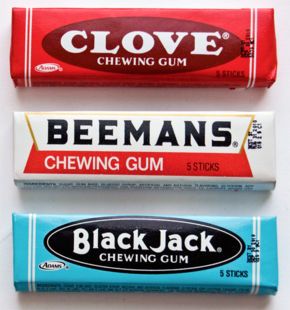Free Shipping on Orders over $49 (Retail Only)
Shop Now
- Address: 144 High Street Harpers Ferry, WV 25425
- Shop: 304.461.4714
- Orders: 304.535.8904

The iconic Black Jack, Clove and Beeman’s Gum have gone in and out of fashion for years. They left the market in 1978, returned in 1985 and, just a few years back, vanished again. And now – they’re back! Again! This much hailed return begs the question ‘where did they begin in the first place?’ The answer to that question requires a timeline of sorts which goes back to the origin of commercial chewing gum, which is unexpectedly recent.
Throughout History: People everywhere have chewed tree resin to clean their teeth, heal gum and tooth problems, and ease other bodily distress. The oldest chewed resin – circa 9,000 years ago – was found in Sweden and contains tooth marks from a Neanderthal teen.
1840s: Maine-native John Bacon Curtis developed the first commercial chewing gum – “State of Maine Pure Spruce Gum. He started selling his goods cross-country before railroad tracks were laid or the luxury of cars. In 1852, Curtis opened the Curtis & Son Company where about 150 employees produced 1800 boxes of gum a day. The chewing gum industry was born.
1856: Deposed president of Mexico, General Antonio López de Santa Anna (best known as the guy who led the charge against the U.S. in the legendary Alamo… and killed Davy Crocket), needed to find sanctuary. So he went to (where else?) Staten Island New York, bringing chicle, the resin from the sapodilla tree, with him. He planned to make rubber. He hooked up with light merchant Thomas Adams who used it to create chewing gum, instead. His product: “Adams’ New York Gum No. 1 – Snapping and Stretching…” a softer version of the spruce gum.
1860s: Adams gum was good, but pretty tasteless and sales were lackluster. So Adams added sugar and sales skyrocketed. Next, he added licorice flavor, creating the first flavored gum – Black Jack Gum, which he also marketed as a remedy for colds. That was followed by “Tuttie Fruit Gum,” the first fruit-flavored gum, sour orange, and, around1914, Clove.
Late 1800s: Dr. Edward E. Beeman, an Ohio-based physician and researcher, created Beeman’s Gum – later called Beemans Gum – to aid digestion. The base of Beemans, and virtually all American chewing gums through the mid-1940s, was Santa Anna’s chicle.





